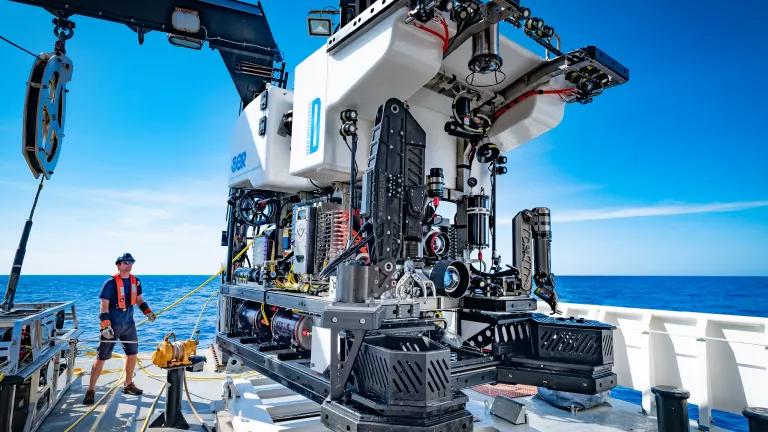We Can’t Afford Cuts to Coastal Management
The Trump Administration seems hell-bent on cutting critical programs that protect the lives, livelihoods, and way of life for the 124 million people who call our ocean and Great Lakes coasts home.
The Administration’s proposed 2018 federal budget: “[z]eroes out … grants and programs supporting coastal and marine management, research, and education … [because they] are a lower priority.” But why wait until next year? Soon after the Administration’s proposed budget dropped for 2018 the White House signaled its interest in eliminating some of these programs even sooner as part of Congressional efforts to hammer out a budget that carries our country through the rest of 2017. Elimination of federal funding that protects homes and stimulates coastal economies could come as soon as this month – with many programs impacted as soon as this summer and fall – if Congress adopts the Administration’s 2017 budget requests.
These cuts will bring serious repercussions to all who live, work, and visit America’s ocean and Great Lakes. In fact, if you care at all about our oceans and coasts, you should be concerned about a world without National Oceanic and Atmospheric Administration (NOAA) funding for programs like:
- The Coastal Zone Management Program, which funds 34 states and territories to protect coastal water quality, ensure coastal habitats are able to buffer homes and businesses from storms, sustain healthy fish and wildlife populations, and keep beaches open for tourists and residents to enjoy. State coastal zone managers check that proposed offshore industrial activities, like wind energy development, are in line with what residents want for their local waters.
- Regional Coastal Resilience Grants, which fund states and local governments to help address regional coastal challenges, like ocean acidification.
- The National Estuarine Research Reserve System, designed to protect and study some of the most biologically-productive places on the planet from the Hudson River to San Francisco Bay.
- The Sea Grant Program, which funds coastal researchers at hundreds of universities nationwide to work with local businesses and stakeholders to develop solutions for on-the-ground challenges, like reducing the Great Lakes’ nutrient pollution and improving methods for Gulf of Mexico oyster aquaculture.
NOAA programs help communities struggling with the real and immediate impacts of climate change, like sea level rise and coastal flooding, and cannot be another casualty in this Administration’s war on science.
Given the dramatic and often indiscriminate nature of the various proposed cuts, it’s hard to say how exactly states will be able to plug the holes left behind. When it comes to coastal programs, states often can’t pick up the entire tab for programs that benefit the 39 percent of the U.S. population that lives along the coasts. Virginia could lose their coastal zone managers altogether and New York might see a reduction of up to half of their coastal staff. California’s Coastal Commission receives 10 percent of its budget through coastal zone management grants to the state – staff would be laid off and other cuts would likely be needed to fill the funding gap.
The loss of Coastal Zone Management Program funding means fewer people to review offshore development proposals—perhaps impacting permitting speeds and likely resulting in less than optimal oversight of our public coastal and ocean resources. With ocean and Great Lakes use growing rapidly—from both traditional uses like shipping, fishing, and recreation, and new industries like aquaculture and offshore renewable energy—delays will make a dent in our ability to grow the blue economy. Just oceans alone currently contribute hundreds of billions of dollars in goods and services to the country’s GDP and employ millions of people—with ocean related employment growing almost twice as fast as the U.S. economy as a whole.
The NOAA Coastal Zone Management Program is structured to allow states a great deal of autonomy to use funding in a way that best benefits the particular needs of their communities, be that by revitalizing working waterfronts to protect their unique culture and coastal economies, developing CoastSmart Communities to help address flooding, or engaging commercial and recreational fishermen in upfront discussions about where to best site potential wind development areas. Budget cuts would put waterfront towns at greater risk in the face of sea-level rise and intensifying storms, and would jeopardize local communities’ voices in ocean decisions.
State coastal zone staff also serves an important role in addressing regional ocean challenges that, by nature, flow beyond arbitrary state lines. For example, in the Mid-Atlantic, coastal managers are working together to:
- Launch the Mid-Atlantic Coastal Acidification Network, which brings together scientists and agency and industry representatives to share information on the challenges facing shellfish and fisheries as a result of ocean chemistry changes. Acidic water makes it harder for many species of shell-building organisms, like oysters and scallops, to grow their protective coverings and survive.
- Develop a shared strategy for reducing marine debris (e.g., uninflated balloons that sea turtles mistake for food, often causing internal damage and eventual death).
- Build the Mid-Atlantic Ocean Data Portal, a public, centralized, user-friendly website with more than 3,000 layers of state, federal, and stakeholder data on ocean uses and marine life. From recreational use and shipping traffic, to fishing and habitat and species distributions, the portal provides a shared starting point for discussions about ocean projects and promotes better decision-making.
Too many people rely on healthy oceans and coasts for Congress to turn its back on funding. Over 32% of America’s coastal value comes from tourism, recreation, and the fishing and seafood industry, which depend on clean water, clean beaches and abundant fish and wildlife. These industries employ nearly 2.3 million people, supporting 74% of all coastal jobs.
NRDC urges Congressional leaders to reject the proposed NOAA budget cuts.




